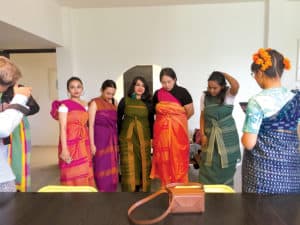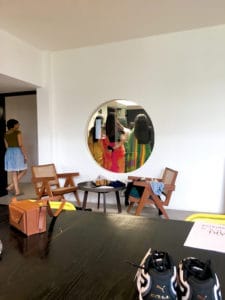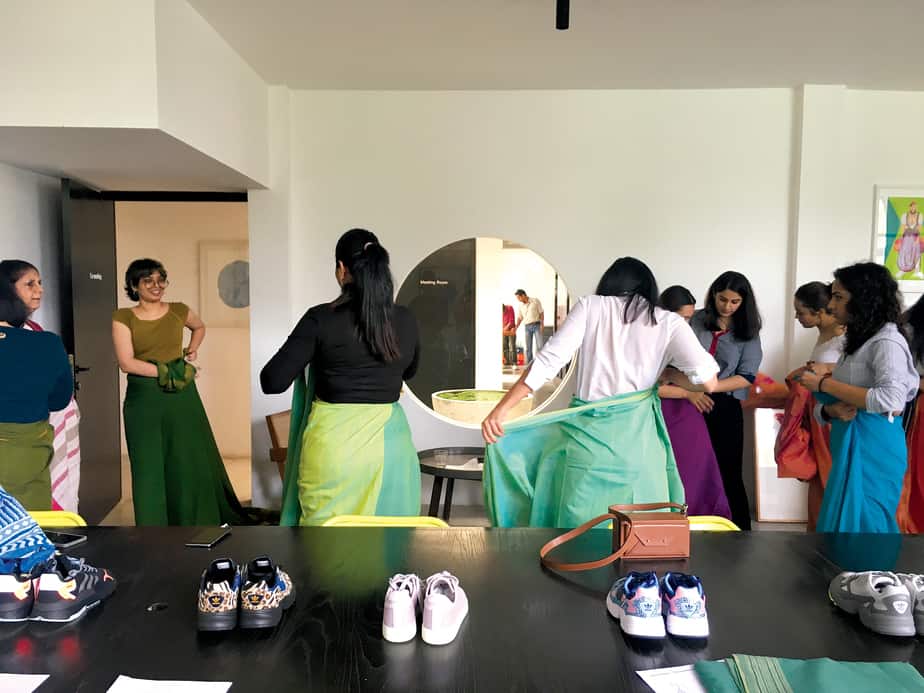When a textile historian gets together with a sneaker brand to hold a workshop, some unusual matchups take place
A conference room is an unlikely place for a bunch of sari enthusiasts to sit together and discuss its journey and the various ways it is worn in. Yet this dark room with a wall lit with projections exploring the unstitched garment has a group of young adults listening to Rta Kapur Chishti, the textile historian behind the Sari School.
This is not the first instance Chishti is hosting a workshop. However, this particular setting has a contemporary undertone to it. It is, in fact, a collaboration between VegNonVeg, the sneaker retail brand, and Taanbaan, her textile label. The idea is to experiment with various sari drapes alongside the streetwear staple that a pair of sneakers is.
Shivani Boruah from VegNonVeg is here, who explains the relevance of this workshop and how she looks forward to many millennials include the sari in their daily wardrobes. Jhunjhun Jain, an artist, is representing the venue i.e. The Pond, a concept store as their brand and culture manager. All young, inspired.
Rta Kapur starts with giving the gist of her journey so far. Her assistants, one of whom is her daughter, change the slides on display as the textile scholar describes what each one of them entails. She explains the anatomy of a sari: How its inner end holds a woman’s girth, the outer end covers her upper body and is also used to carry things around. The length in between goes around the legs and the body. She tells how a sari traditionally doesn’t need the addition of fabric stitched across its lower end, the ‘fall’.

Between important details regarding textile development and the significance of using desi cotton, she also takes a jab at Modi and his government. She is clear that 70 years is not enough time for India to fulfil something that the West did in 250 years. She is positive that khadi and local production will get there at some point.
Her presentation has some interesting details that make us wonder and cringe at the same time. Like how the weaving was banned in Goa by the Portuguese for the longest as textiles were instead brought from Portugal and sold in the locality. It was time for her to demonstrate how to turn a few yards of fabric into a gown, pants, shorts, pantaloons and much more.
On being asked what she aspires to do with such workshops, she replies, “To be more inventive, to be able to recreate something that can be worn today.”
We shift to a larger room, a co-working space filled with sunlight, where some 10 girls and a guy choose the ‘practice’ saris from the bunch that team from the Sari School is carrying with them. Another fresh set of handwoven saris is hung on a rail across the room, priced between Rs 5,000 and Rs 10,000.
A colourful collection of sneakers from top shoemakers that retail at VegNonVeg are lined up at the table for everyone to add on to their looks. Deeksha from the school’s team shows us four ways to tie a sari, each from a different state in India. On asked how often they do such workshops, she says not very often. The idea of the Sari School according to her is to support the slow-moving process of textile weaving behind the label Taanbaan.

As Deeksha folds and drapes bits of fabric around her body, everyone else follows suit. The room is full of girls and a guy, Rajat Sodhi studying the art of origami that draping a sari is. Colourful lengths of fabric get twisted and tied around bodies in unison as if a performance. Some who have only seen their mothers or people in images wearing one, struggle to make sense out of this straight length of textile.
As everyone helps each other, fastening parts of fabric around their bodies, they also share their backgrounds and their intention of joining the workshop. Sodhi, who is an architect by profession, is also practising Kalaripayattu, the Keralite martial art. The idea for him to come here was to learn a few drapes and develop one for himself. Girls who are bloggers and artists are also part of the affair.
Rta Kapur goes on to help each of the participants, as everyone has a different body shape and requires unique adjustments to let the saree sit on their frames seamlessly.
Some girls giggle about how they were going to use the loo in a saree especially in a drape that covers their legs separately. The practicality of a saree for a denim-wearing clan is a demanding thought. However, they keep at it and look forward to the next drape that Deeksha expresses through words and action.
There have been initiatives in the past that document about 108 sari drapes that India has to offer. One of them is a book by Chishti herself called, Saris: Tradition and Beyond and The Sari Series by Border&Fall, a video sequence that demonstrates various sari tying techniques from around India. But a community gathering like this has a character of its own, where there are material, action and dialogue to explore – rather than learning something of a book or the internet.





